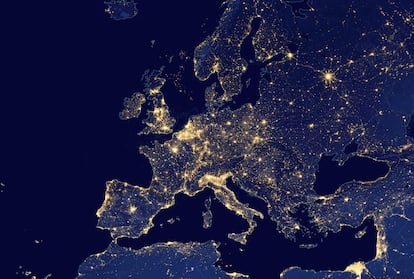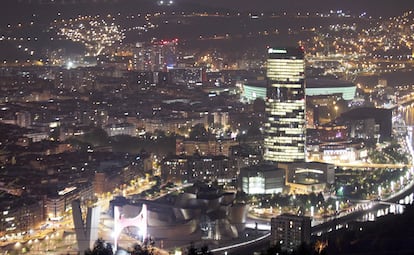The city lights are bringing spring forward and autumn back.

Streetlights, neon lights, and LEDs in shop windows are confusing plants: in cities, spring arrives several days earlier than in the countryside, and autumn is also delayed by almost two weeks. Research published in the scientific journal Nature Cities shows how light pollution acts like the sun, accelerating fundamental processes in plant phenology, such as budding and leaf fall. Researchers believe that city lights are altering plant life, the consequences of which are yet to be determined.
Light pollution is already preventing us from seeing the stars . Recent studies have also shown how excessive artificial lighting in cities is affecting the behavior of urban animals and human health . At the same time, many studies have confirmed that spring is arriving earlier in cities . But they pointed to global warming, which is intensified in urban environments by the so-called urban heat island effect : the concrete in buildings, the asphalt in streets, the height of buildings, and the entire urban design trap heat. Now, light pollution is added to the equation, and the result is the widespread disruption of urban vegetation.
The study, published in Nature Cities, found that, on average, city centers turn green about 12.6 days earlier than plants in the surrounding countryside. At the other extreme, leaf senescence begins in cities an average of 11.2 days later. The phenomenon is also widespread. The study tracked the start of the plant growing season in 428 large cities in the Northern Hemisphere. These changes in plant phenology were observed in 378 of them, or 88.3%. To detect these changes, they used sensors from several satellites and data since 2014.

“Satellites detect differences in greenness by measuring the amount of light reflected from the Earth’s surface,” explains Lin Meng, a researcher at Vanderbilt University (United States), a co-author of the study. They carry instruments on board that capture this reflection at different wavelengths, particularly in the visible and near-infrared (NIR) parts of the spectrum. “Vegetation strongly reflects NIR light while absorbing visible red light for photosynthesis,” Meng adds. They capture this using markers such as the Normalized Difference Vegetation Index (NDVI). “Areas with denser vegetation or higher photosynthetic activity reflect more NIR light and less red light, resulting in higher NDVI values,” the researcher explains.
By comparing these reflectance patterns in cities and nearby countryside, satellites were able to detect spatial changes in greenness. The study uses a gradient from the most remote areas to the city center itself. In the case of Barcelona, for example, the rural area monitored for comparison is located 32 kilometers from the city center. In the Catalan capital, they found that the growing season is 14 days longer in the urban core compared to the more remote rural areas.
The other major contribution of this work is that it manages to disaggregate the causes of this urban-rural differential. The authors also used satellites to measure the degree of light pollution. Under natural conditions, on a cloudy night, luminosity is around 0.6 millilux (a lux measures the amount of incident light). If there are no clouds, with a full moon at its zenith, the figure can reach 0.3 lux. But in cities, the luminosity ranges from 7 to 65 lux. Previous studies have shown how the nighttime environment becomes almost 10% brighter each year for more than a decade . But until now, temperature has always been the key to explaining phenological changes in urban flora.

“We used a statistical analysis method, partial correlation analysis, to disaggregate the impact of temperature from the impact of artificial lighting on vegetation phenology,” Meng explains. “Partial correlation measures the degree of association between two random variables, eliminating the influence of a set of control variables. This allows us to isolate the effect of each factor on the target factor while controlling for other factors,” she explains. They found that both temperature and light variables affect the length of the plant growing season. They also found that the latter has a greater impact in four of the seven major climatic regions covered by the study, ranging from warm, dry cities like Dallas to cold, dry cities like the cities of Canada.
Meng goes into detail about cities: “Cities with higher artificial light intensity have a greater impact on phenology,” he says. Since levels vary seasonally, their influence differs between spring and fall. “In particular, many American cities showed higher luminosity during spring. In contrast, European cities have higher light pollution in the fall, so they showed a greater influence at the end of the growing season, in the fall,” he adds.
Regarding the consequences for flora, Dunxian She, a professor at Wuhan University (China) and first author of the study, points out that an earlier spring and a later autumn can have both positive and negative effects. “In natural ecosystems, a longer growing season could improve productivity and carbon sequestration, thus contributing to climate change mitigation. However, it could also affect local ecosystems if new species become more dominant, leading to changes in biodiversity, especially with the introduction of exotic species for urban landscape design,” he says.
Artificial light lengthens the photoperiod, acting as an extension of daylight. For the authors of the research, this lengthening could alter the accumulation of signals that initiate budding or senescence, such as a reduced efficiency of photosynthesis. But the disruption goes deeper. Plants perceive light differently depending on its wavelength. Photochromes are proteins that function as photoreceptors sensitive to red light, while cryptochromes are sensitive to blue light. The latter is the driving force behind the LED revolution, and the consequences of this remain to be investigated.
Georg Wohlfahrt is the head of the biometeorology group at the University of Innsbruck (Austria). Although he did not participate in this work, he was the lead author of a pioneering paper that found that spring was arriving earlier in cities . His work pointed to the heat island effect and environmental pollution, but also recognizes the role of light pollution. “Apart from non-seasonal climates, such as the tropics, plant phenology depends on temperature and the quality/quantity of light,” he recalls in an email. “Artificial light in urban areas modifies plant light exposure and, therefore, phenology. This is not new. The novelty of the Nature Cities article is that it addresses the problem on a large scale in a large number of cities and attempts to disentangle the effect of artificial light from that of the urban heat island,” he adds.
If anyone knows about light pollution, it's Christopher Kyba. A professor at the GFZ Helmholtz Research Centre for Geosciences (Germany), he has been researching the impact of artificial light for over a decade. To do so, he's created a network of scientists, citizen science projects, and even an app to measure the loss of nighttime light . The results of his latest project have just been published in the same issue of Nature Cities , unrelated to the study of the 428 cities. The citizen science work coordinated by Kyba has collected data from 33 German municipalities, finding that, after midnight, more than one light per inhabitant remains on. What's revealing is that for every streetlight left on, there's an illuminated neon sign or shop window.
“I see reasons for both hope and fear,” Kyba says about the future of light pollution. “On the one hand, there are examples of cities and even entire countries in wealthy, industrialized areas of the world where we see decreases in light emissions after midnight,” he says in an email. “On the other hand, the vast majority of cities and countries around the world continue to increase their lighting.”
EL PAÍS





